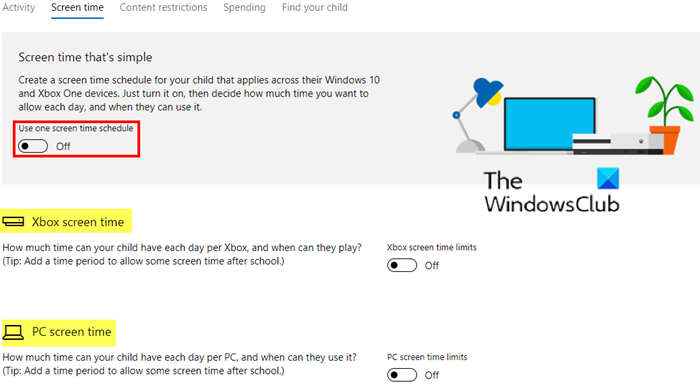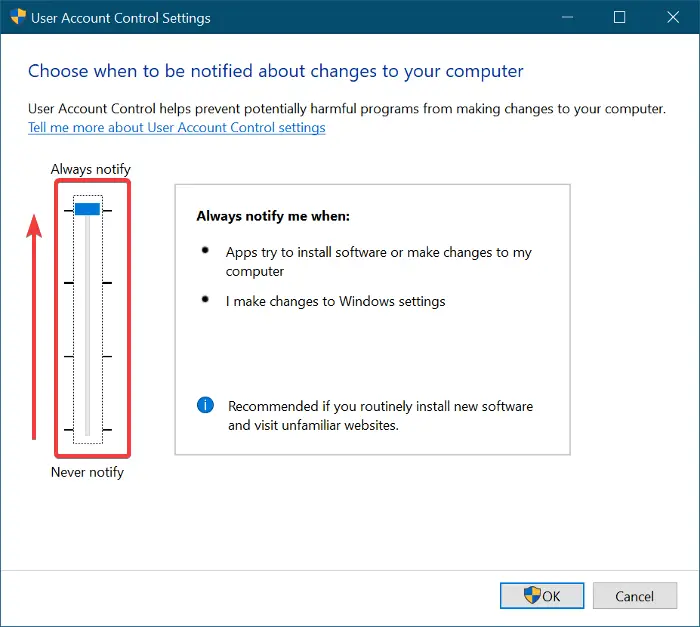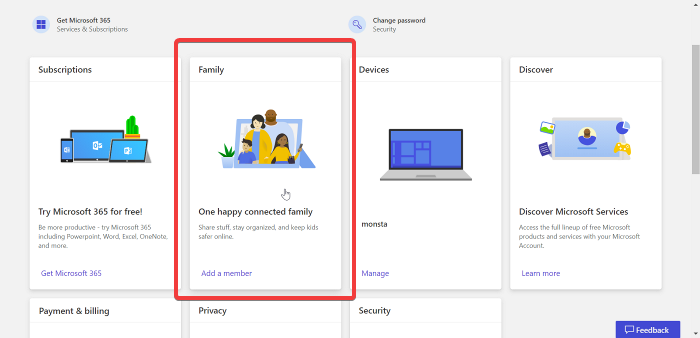Microsoft installed the Family Safety feature to restrict underage users’ usage in several ways, including limiting the time they spend on the system. If you notice that Screen Time Limits feature is not working on Windows 11/10 PC or Xbox One, then this post might interest you. This post will outline the measures you can take to redress the issue.
For a breakdown of your child’s overall time spent on each of their devices, the Screen time section indicates when and for how long your child used their devices throughout the week. You’ll see a list of how much time they spent on their devices overall by each day, and also how much time they spent on each device during the entire week.

To adjust your child’s screen time limits, visit Microsoft Family.
To set screen time limits for your child on Xbox and Windows devices:
- Go to your family group
- Find your child’s name and select Screen time.
- Set the schedule for devices together or separately.
Screen Time Limits not working on PC or Xbox
If you set up screen time but find that the Screen Time Limits feature is not working as expected, here are a few things you can try:
- Set up one schedule
- Update Windows 10
- Restart your device
- Sign in
- Keep it in the family group.
1] Set up one schedule
With the latest update of Windows, you’re able to set up one schedule that’ll apply to all of your child’s devices. This means if you give them five hours in a day, they’ll have five hours between their Xbox One and Windows 10 devices. Otherwise, time gets tracked separately, so one hour of screen time means one hour per device.
2] Update Windows
Select Start > Settings > Update & Security > Windows Update > Check for updates and install any available updates.
3] Restart your device
Select Start > Power > Restart.
4] Sign in
Make sure your child is signed in with their Microsoft account on their device. If they are, you can check to ensure their account is syncing upright.
Select Start > Settings > Accounts and follow the prompts to verify their account.
5] Keep it in the family group
Accounts outside of your Microsoft family aren’t subject to screen time limits that you set.
To prevent kids from creating new accounts, on your Xbox, do the following:
- Press the Xbox button.
- Select System > Settings > System > Signed-out content restrictions.
- Create a guest key and turn off Let people download & make new accounts.
From now on, you’ll need a guest key to add new accounts.
Read: How to Set up and Use Parental Controls in Windows 11.
Screen Time Limits not working in Xbox or PC
If the Family Account screen time limitation is still not working on your system, here are other things you could try:
- Use the right User Account Control and system settings.
- Remove the parental control settings.
- Verify the Child’s account and activate it.
- Change the user’s account type.
- Make a new child user account.
- Disable battery saver mode from the Group Policy Editor.
- Disable battery saver mode from the Registry Editor.
Read the sections below for in-depth guides on fixing the Family Account screen time limitation issues.
1] Use the right User Account Control and system settings
Microsoft Family Safety works with User Account Control (UAC). Family Safety needs UAC to be configured correctly to prevent errors. Let’s see how to configure UAC to work with Family Safety.
Start by launching Change User Account Control Settings. You can do this by searching for it in the Start menu and selecting the option. Here, drag the slider all the way up towards Always notify and hit the OK button to save your settings.

Next, click on the Start menu again, search for, and open Diagnostics & feedback settings. Click the dropdown menu for Windows should ask for my feedback under Feedback frequency and change it to Never.
Go down to Diagnostic and usage data and select Enhanced (or full) from the dropdown menu for Send your device data to Microsoft.
Next, return to the Start menu and search for Reputation-based protection. Select Reputation-based protection from the results and toggle on the switches for every option on this page.
Press the Windows key again and search for background apps. Click on Background apps from the results. On the screen that opens, find Microsoft Edge and click the switch next to it to toggle it on. This allows Edge to run in the background.
Finally, restart your computer, and the problem should be gone now. If it persists, proceed to try out the next solution below.
2] Remove the parental control settings
Open your internet browser and visit your Microsoft account page. Here, click on the Family tile.

Next, choose a Time Slot and hit the Remove button. Do the same for all of the time slots on the problematic account and remove all of them. After deleting all the time slots, close your browser and restart your computer system.
When the PC comes back on, go back and re-add the time slots you deleted. Following this, restart the machine again, and the Family Account screen time limits will now work.
3] Verify the Child’s account and activate it
A common reason the Family Account screen time limitation will not work on the child account is that you’ve not activated or verified it. If you’re not sure how to do these, follow the guide below:
Press the Windows key + I key combination to open Windows Settings. Here, go to Accounts and go to Your info on the left-hand panel.

Next, select the Verify option on the right-hand area and continue with the process that opens in a new window. You will have to verify your account using the phone number or email address linked to the account.
Alternatively, if you don’t see the Verify link, you’ll have a Fix option under the Email & Accounts tab. Use this option to troubleshoot your account problem.
The above steps should resolve any issues you have with the Family account. Some users have complained that verifying their account doesn’t work for them. If the verification doesn’t resolve your issue also, you have to activate the account.
Return to the Your info tab and select the Manage my Microsoft account option. This opens up your internet browser. Click on Sign in and enter your Microsoft credentials to log in to your account.
To activate the child account, you must enter your credit card information and pay 50 cents. At this point, the Family Safety Screen Time verification should work perfectly.
4] Change the user’s account type
If the child’s account is of an administrator nature, the Family Screen Time Limits may not work because they don’t apply to administrative accounts. If the child account is an administrative account, you have to change it to a standard account to get the Family Screen Time Limitations to work. If the account is an Active Directory account, you must create a new one.
For this, you have to log in to the child’s system as an administrator. Next, right-click on the Start menu button and select Computer Management.
After that, expand Local Users and Groups and choose Users from the right-hand area of the child account. Choose the Properties option and go to the Member of tab. Click on Administrator and select the Remove option. Do the same for all the user groups in the tab.
Next, click on the Add option at the bottom of the screen and click on Advanced. Hit the Find Now button on the left-hand pane and double-click on Guests. After that, hit the Ok button and do the same for the Users group.
Finally, click on the Apply and OK buttons and restart the child’s computer.
5] Make a new child user account
Go to the child’s computer and follow the steps in this article to create a new local user account. Ensure that the account is not of the administrator group but standard. Log in to the computer using the local user account you just created.
Next, press the Windows key + I key combination to launch Windows Settings and go to Accounts. Switch to the Your Account tab on the left-hand panel and click on the Sign in with a Microsoft account instead link.
Finally, log in with the child’s account details and confirm that the Family Safety Time limits are now fixed and working perfectly.
6] Disable battery saver mode from the Group Policy Editor
The battery saver on Windows can override the Family Screen Time Limitations on the computer. To workaround this, you have to disallow the user from activating the battery saver.
NOTE: On disabling battery saver, even system admin accounts can’t enable battery saver mode if they don’t revert the changes.
Log in to the Windows system using an Admin account to begin the process. Next, click on the Start menu button and search for group policy. Click on Edit group policy from the search results.
Expand the left-hand pane of the Local Group Policy Editor window and navigate to:
Computer Configuration > Administrative Templates>System>Power Management > Energy Saver Settings.
Next, click on the Energy Saver Battery Threshold (on battery) item and hit the Enabled option. Select Threshold and change the threshold to 15%. Save your changes by clicking on Apply or OK. This closes the Group Policy Editor.
Related: This device is locked because of family settings for screen time.
7] Disable battery saver mode from the Registry Editor
Press the Windows key and type cmd. Right-click on Command Prompt and select the Run as administrator option from the context menu. Type the following command in the Command Prompt window and hit the ENTER key:
reg add HKEY_LOCAL_MACHINE\SOFTWARE\Policies\Microsoft\Power\PowerSettings\E69653CA-CF7F-4F05-AA73-CB833FA90AD4 /v DCSettingIndex /t REG_DWORD /d 15
Exit Command Prompt and restart your machine. This fix should resolve all issues you are experiencing with the time limitations. If you wish to re-enable battery saver from the Registry Editor, all you have to do is launch an elevated Command Prompt window and run the following command:
reg delete HKEY_LOCAL_MACHINE\SOFTWARE\Policies\Microsoft\Power\PowerSettings\E69653CA-CF7F-4F05-AA73-CB833FA90AD4 /v DCSettingIndex
I hope this helps!